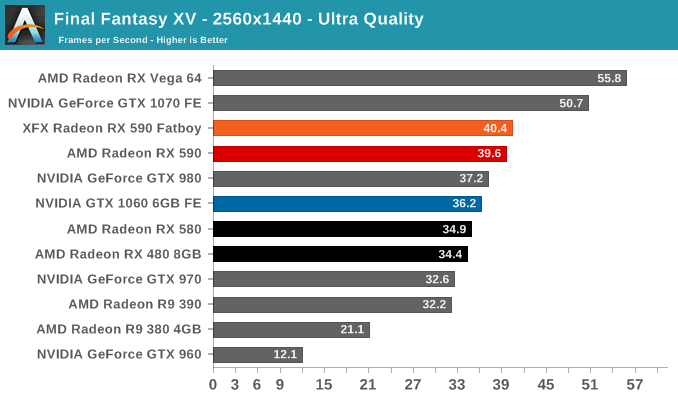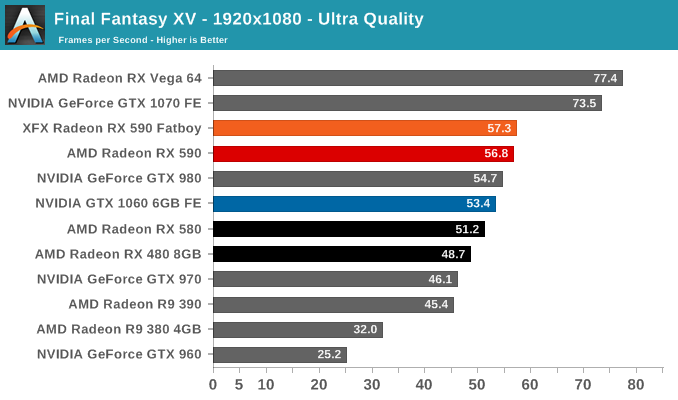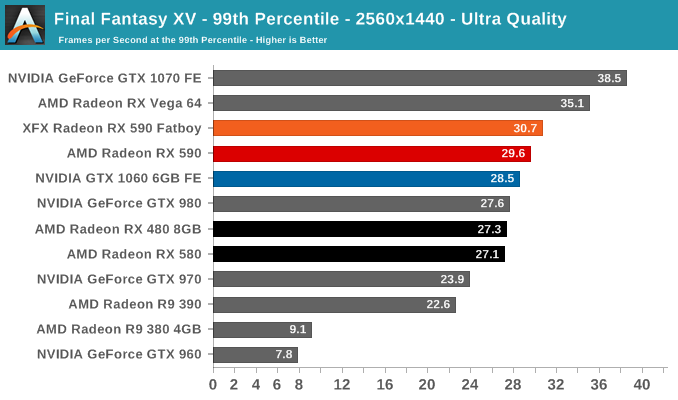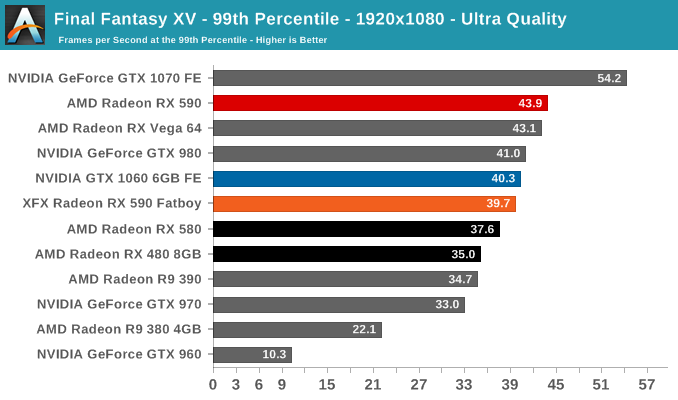The AMD Radeon RX 590 Review, feat. XFX & PowerColor: Polaris Returns (Again)
by Nate Oh on November 15, 2018 9:00 AM ESTFinal Fantasy XV (DX11)
Upon arriving to PC earlier this, Final Fantasy XV: Windows Edition was given a graphical overhaul as it was ported over from console, fruits of their successful partnership with NVIDIA, with hardly any hint of the troubles during Final Fantasy XV's original production and development.
In preparation for the launch, Square Enix opted to release a standalone benchmark that they have since updated. Using the Final Fantasy XV standalone benchmark gives us a lengthy standardized sequence to utilize OCAT. Upon release, the standalone benchmark received criticism for performance issues and general bugginess, as well as confusing graphical presets and performance measurement by 'score'. In its original iteration, the graphical settings could not be adjusted, leaving the user to the presets that were tied to resolution and hidden settings such as GameWorks features.
Since then, Square Enix has patched the benchmark with custom graphics settings and bugfixes to be much more accurate in profiling in-game performance and graphical options, though leaving the 'score' measurement. For our testing, we enable or adjust settings to the highest except for NVIDIA-specific features and 'Model LOD', the latter of which is left at standard. Final Fantasy XV also supports HDR, and it will support DLSS at some later date.


For Final Fantasy XV, the older R9 380 and GTX 960 simply can't keep up with the demands and are essentially unplayable with particularly low 99th percentiles. VRAM wouldn't be the sole issue - though FFXV does use high resolution textures - as the GTX 980 (4GB) performs up to par. NVIDIA hardware tends to perform well on FFXV but as with Ashes: Escalation, the RX 590's extra performance permits it to claim victory, reference-to-reference, which the RX 580 was unable to do here.













136 Comments
View All Comments
mapesdhs - Thursday, November 15, 2018 - link
Very true, though I suppose wrt the 590 this kinda works against AMD a bit since pretty much all the optimisation that the 590 could ever have benefited from is already there.sasquatch85 - Thursday, November 15, 2018 - link
I think there are quite a few owners of pitcairn-based cards that would object page 2. That GCN1 architecture made it from 78xx in 2011 up through the R7 370 in 2015. Polaris always seemed to be aiming to replace that core in the lineup and definitely fit right in at the same price levels. However, I never thought that actual performance difference was enough to justify a purchase until this 590, but that comes at a much higher price. I think I can still hold out with my 7870 for the next mid-range architecture on 7nm before finally scratching the upgrade itch.edzieba - Thursday, November 15, 2018 - link
"This is enabled by being fabbed on 12nm and being afforded higher TBPs"Traditional Buttered Pixels? Total Bungholiomark Points?
JoeyJoJo123 - Thursday, November 15, 2018 - link
Total Board Power? Because the GPU is more efficient at a 12nm process, they can spend that extra headroom overclocking the chip to run faster. That was the point of the statement.edzieba - Thursday, November 15, 2018 - link
I think it was a typo of TDP, I was just having some fun.PeachNCream - Thursday, November 15, 2018 - link
TBP is not a typo. I think it's Typical Board Power or, as Joey said, Total Board Power. AMD was swinging that term a year or three ago (not really sure when they started that) for some marketing-driven reason and, in the absence of better power and heat numbers to refer to, tech journalists are forced to resort to it in the articles they write.eastcoast_pete - Thursday, November 15, 2018 - link
@Nate: thanks for the review. Now, I know that this card (and the 1060 from Nvidia) are targeted for gaming at 1080p or 1440p with high or ultra settings, but I would have liked to see how this card does in UHD. If you have any data, please share them - Thanks! Now, I don't expect the Rx 590 or 580 to provide playable frame rates for all games in UHD, but I like to now how close these mid-rangers come to the higher-end cards when they really stressed (UHD with some goodies turned on). Plus, the extra 2 Gb of VRAM vs. the 1060 might make it possible to handle games the 6 Gb 1060 can not. Any information? Thanks!KateH - Thursday, November 15, 2018 - link
A 40CU config (as was initially rumored) would have been much more interesting- at >1500mhz boost such a card would be nipping at the heels of the GTX 1070 and at around $320 it would have been a great deal even if the TBP hit 250W but this is kind of mediocre, even if it's a bit faster than the 1060. If the price undercut the 1060 it would be a good deal but at higher price AND power? Not worth it unless Freesync is important to you. I heard some variants could clock up to 1680mhz- I'd be curious to see how that performs.Arbie - Thursday, November 15, 2018 - link
Thanks for the good article, and the inclusion of Ashes in the comparison charts.boozed - Thursday, November 15, 2018 - link
"Meh"